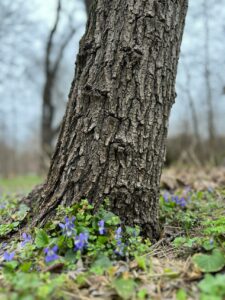Tree felling is a dangerous operation that requires careful planning and execution. A wrong cut can result in serious injury to the operator, property damage, or even environmental hazards.
There are different types of tree felling cuts and we will be discussing some of them in this article. A directional felling cut, like the Humboldt or open-face notch methods, is essential for safely felling trees. Unlike the conventional method, it allows the hinge to aim downward, reducing the chance of a rolling tree.
Conventional Notch-and-Backcut Method
The conventional notch-and-back cut method is an important part of many felling techniques, allowing for precise and controlled tree falling. Its applications range from removing overgrown trees to felling dangerous and dead ones that pose structural risks. This method requires precise execution and is especially effective when dealing with a large tree, that is either leaning in one direction or heavily loaded on the side it’s being felled. This method also allows for the use of wedges or jacks to initiate the fall of the tree, which further enhances control over its movement.
To prepare a falling tree for the conventional notch-and-back cut, the sawyer must first create a directional notch that will dictate the direction of the tree’s fall. The directional notch is typically cut into the trunk of the tree approximately one-third of the way in from the base, a process that demands careful and precise execution.
After the directional notch is completed, a back cut must be made on the opposite side of the tree, just below the wedge cut and slightly above it. The horizontal back cut serves as a crucial link between the notch and the hinge, providing greater stability and control over the direction of the tree’s fall. It’s also crucial to make the back cut at the proper width to maintain the proper hinge size during the backward movement of the tree, reducing the risk of unexpected shifting or buckling.
In addition to ensuring the accuracy of these two cuts, the feller must plan out their escape route and clear all obstacles before making any final felling cuts. It’s essential to have a clear path of retreat if the tree falls or is unable to follow its intended fall direction, as this can cause serious injury or property damage. It’s advisable to have an escape route that is at least a 45-degree angle away from the direction of the intended fall, as trees have been known to flip or bounce in unforeseen directions.
While this tree-felling technique offers several advantages, it is not without its shortcomings. One of the biggest issues is that it can be difficult to successfully fell a tree with this method if it’s too large or heavily loaded. In these instances, the best course of action may be to call in a professional tree feller.
In addition, the directional notch and back cut can be difficult to establish if the tree has a significant amount of lean or is heavily loaded on one side and notches back. These conditions can increase the chances of the tree kicking back, which has been known to seriously injure and kill people. While the Conventional Notch-and-Backcut method is highly effective, it’s still important to remain vigilant during all tree-felling operations and follow all recommended safety procedures.
Open-Faced Notch
The Open-Faced Notch is a versatile option that is often used in scenarios where the tree has a severe back lean. The wide open angle of the face cut, typically 70 to 90 degrees, gives the tree time to become upright before closing as it falls without being cut downward and forced in an undesirable direction. This method is also very effective for controlling the stem as it hits the ground, particularly in pliable types of wood.
Like the conventional notch-and-back cut method, the open-faced notch can be used to fell both straight and angled trees of any diameter. In addition, it can be used in a variety of terrain, including flat and sloping areas, making it suitable for even the most challenging sites.
As with any type of tree-felling operation, proper planning and execution are critical to a successful outcome. Carefully studying the tree to determine its natural lean and wind direction is essential. This will help you plan your cuts, ensuring that the tree will fall in the desired direction with minimal interference. Clearing the tree service surrounding area of any obstructions is also important, allowing you to safely work within the felling zone.
When using the Open-Faced Notch, it’s important to create a hinge that is proportional to the tree’s diameter. A hinge that is too large will be more likely to break instead of holding wood from separating. This can cause a dangerous snag that could potentially trap you inside the tree or pull you into the path of the falling stem.
Conversely, a hinge that is too small may not be strong enough to hold the weight of the tree and prevent it from breaking free early. This can lead to the infamous “barker chair effect” where the hinge breaks and the tree folds in half, snapping back in the direction of the operator.
To ensure that the hinge is adequate, the directional notch should be cut in line with or slightly above the level of the felling cut. Additionally, it is recommended to use a bore cut to create the notch closure of the hinge and ensure that it is a consistent width across the entire diameter of the notch.
The Open-Faced Notch is an excellent choice for several applications, and it can be used in conjunction with several other felling tools and techniques. However, as with any type of cut, it’s always best to practice on a piece of wood that is not attached to the tree you are working on to gain confidence in your abilities. In addition, it is always prudent to remain mindful of the risks of improper felling and to keep an eye on the tree to look for any changes in its reaction to your cutting. This will allow you to swiftly react if the situation calls for it, ensuring your safety and that of any people or property in the immediate area.
Humboldt Cut
A variation on the conventional notch and back cut method, the Humboldt Cut is typically used with larger trees or when felling on steep hillsides. Its angled bottom cut helps the tree free itself, making it easier to remove from the ground after the fall. It gets its name from the county in California where it’s most often utilized, though it can also be employed elsewhere with good results. This style is a good option for valuable trees with butt swell or other low-value stump wood, as it can preserve more value in the primary butt log than the conventional notch and top cut can.
To effectively execute the Humboldt Cut, the first step is to cut horizontally into the trunk of the tree at about waist height. The precision of this initial incision is important, as it will determine the direction of the tree’s fall. A poorly executed wedge cut or wrong direction can result in a dangerously unpredictable and uncontrolled fall. To avoid this, always ensure that the top and bottom of the wedge cut meet precisely at a 45-degree angle.
Following this, a backcut is made at least an inch above the point where the wedge meets the trunk. This provides additional traction to help the tree free itself from its hinge, which is the area of the cut where the main vertical and lateral branches come together at the base. In addition, the angled back cut will make it more difficult for the top front corner of the tree to fire over the fall, which could cause it to catch on other trees or structures and force the wedge into those surfaces.
As with all felling cuts, the Humboldt Cut can be subject to safety hazards if it’s not properly executed. It’s important to perform a size-up and risk assessment to understand the conditions of the horizontal cut in which you are working and to identify any potential issues (lean, overall soundness, widowmakers, spiked or schoolmarm tops, firewood, etc).
In addition to performing this analysis of falling trees, it’s also critical to consider the location of personnel, structures, power lines, roads, or trails in the cutting area and to clear all obstacles from around the base of the tree before beginning the felling process. It’s also vital to maintain awareness of escape routes throughout the felling process.
The key to safe and effective tree-felling practices is careful planning and precise execution. These steps can help you mitigate the risks of common felling mistakes, which are typically due to a lack of knowledge or insufficient practice. By avoiding these errors, you can increase your efficiency and effectiveness on the job site. Ultimately, regular practice and learning from experienced fellers are the best ways to improve your skillset and ensure comprehensive coverage of all aspects of the tree starting the felling process.






